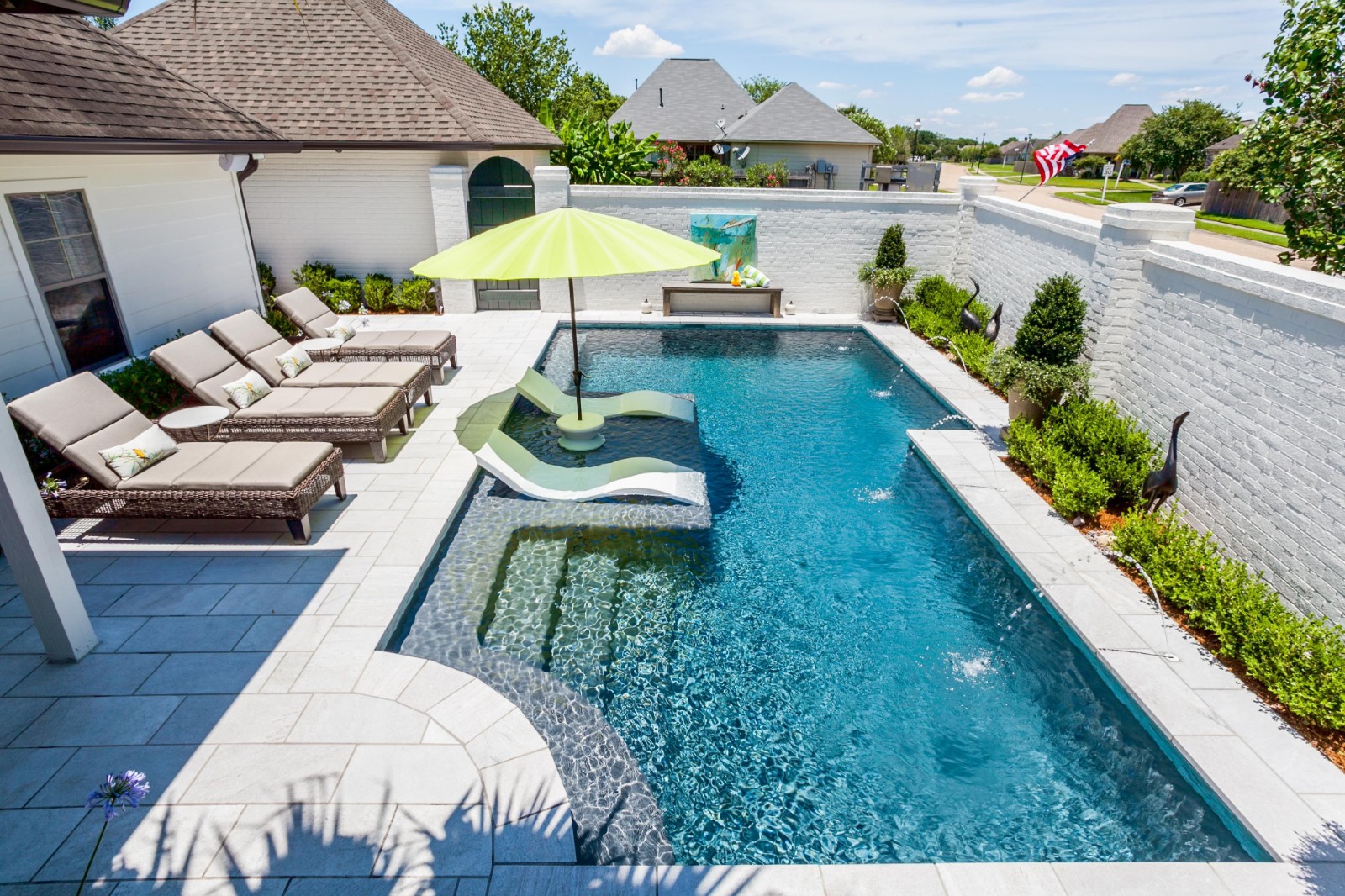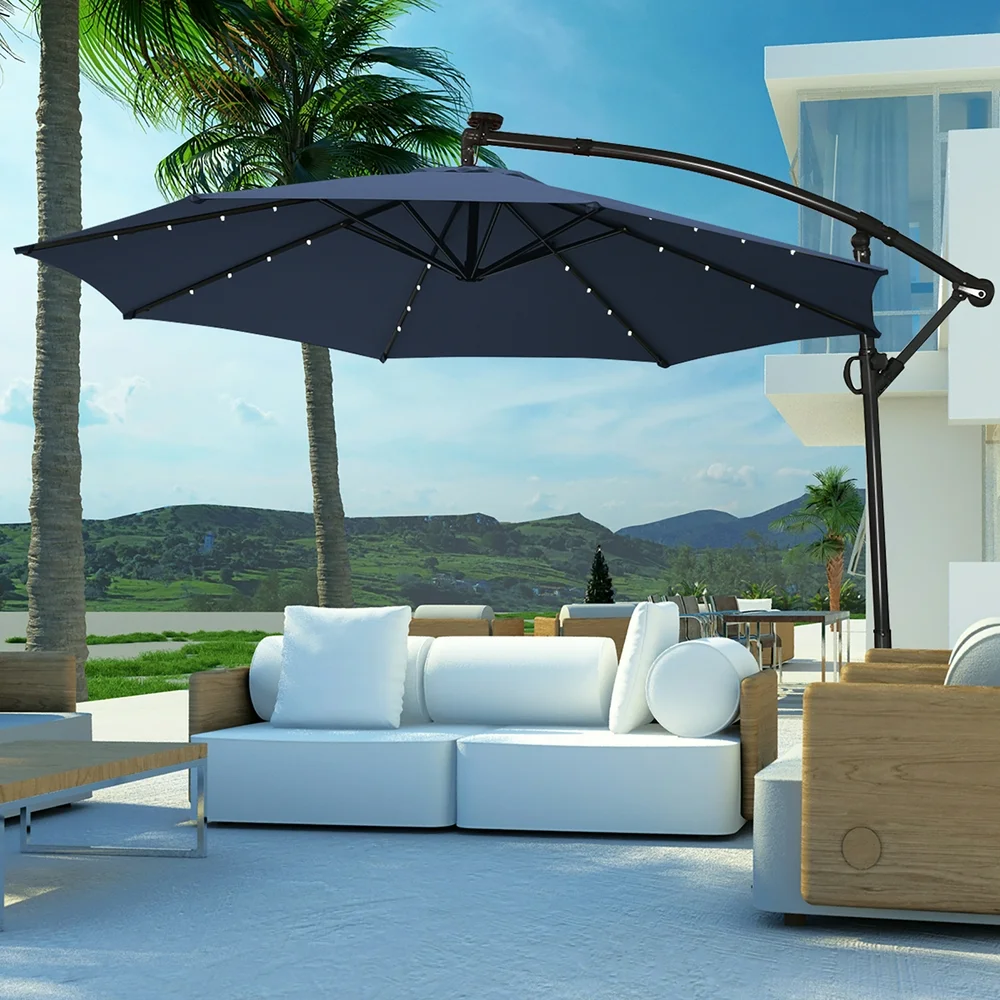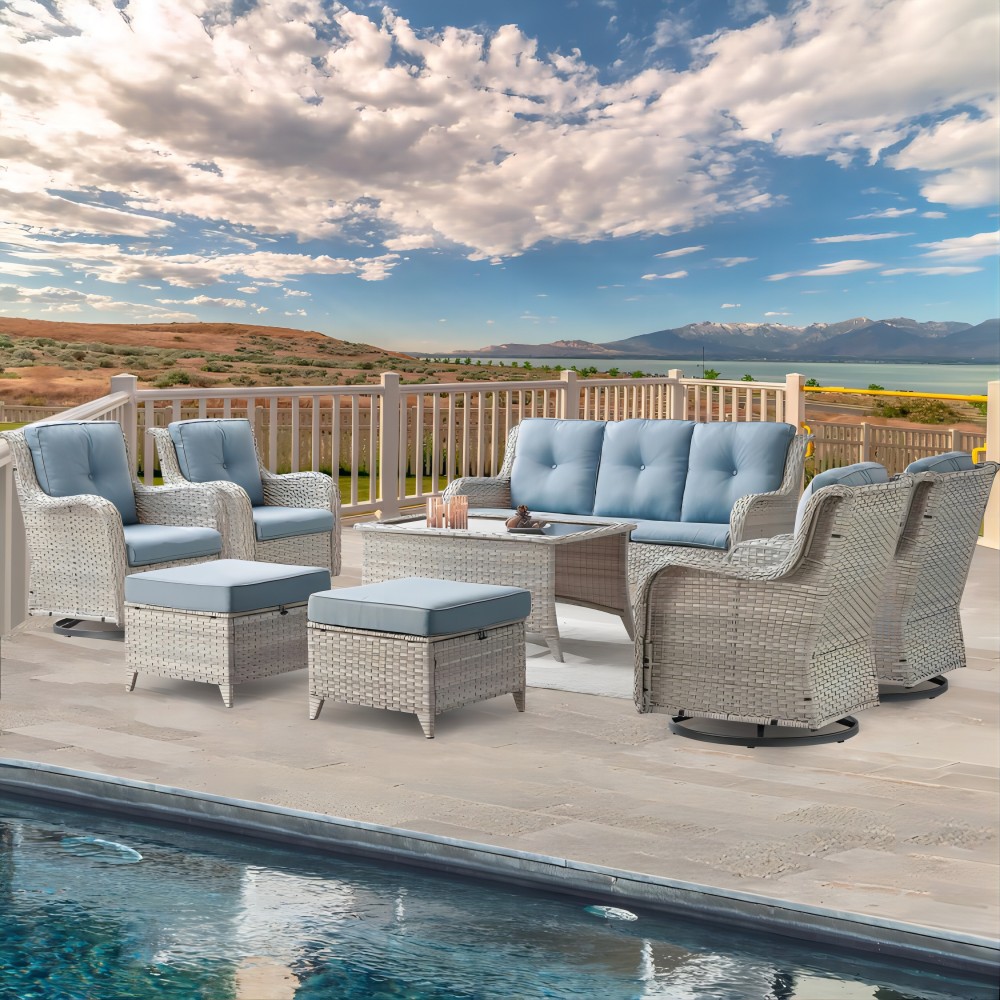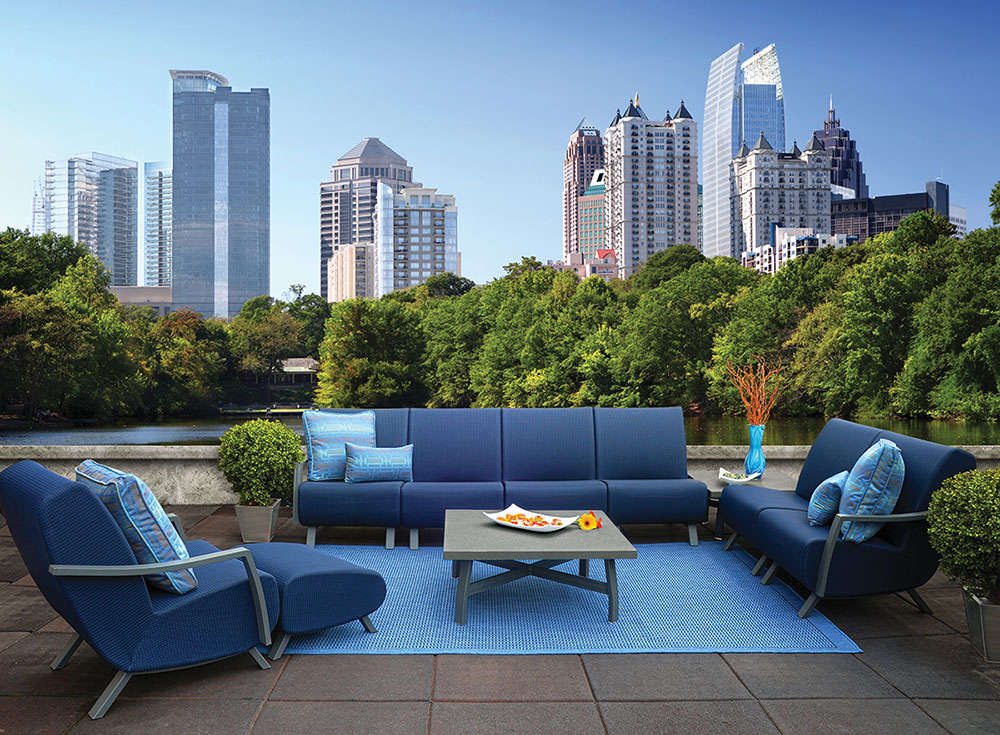
On a sunny afternoon, sitting on the patio with a cool drink in hand, the rustle of the leaves in the breeze and the vibrant green in front of you is an extremely pleasant lifestyle. And the premise of all this is that you have a well-designed and well-planned patio.
Owning a beautiful patio is the dream of every outdoor enthusiast. But to turn dreams into reality, it is far from enough to rely on a few beautiful chairs and a table. Patio arrangement is an art, but also a science that pays attention to layout, design and details. How to create a space on your patio that is both beautiful and practical?
Today, let's talk about the 8 keys to the perfect patio furniture arrangement, hoping that they can provide you with some inspiration to give your patio a new lease of life.
8 Keys to the Perfect Patio Furniture Arrangement:
Key 1: Identify the contact point
Key 2: Find a purpose for your patio
Key 3: Design like a traffic conductor (direct traffic flow)
Key 4: Placement of outdoor furniture
Key 5: Make people feel like at home
Key 6: Separate the outdoor kitchen
Key 7: Divide and conquer, divide the larger space into multiple areas
Key 8: Accessorize and organize

Key 1: Identify the contact point
Before you start moving those heavy chairs, stop and think about what is the core of your patio or patio? Is it the large dining table that can accommodate the whole family for dinner? Or the comfortable sofa where you can sip cocktails with friends? Or maybe a well-designed fire pit that you can gather around to keep warm on a cold night? This core is what we call a "focal point".
Every great patio design revolves around one or more focal points. This focal point is not only a visual focal point, but also the center of the entire space. For example, if your focal point is a large dining table, make sure it is located in the center of the patio and there is enough space around it for people to move and sit comfortably. For those with large patios, there can be more than one focal point.
Imagine a long, quaint wooden table in your patio, with exquisite tableware and flowers on the table and a few comfortable chairs around it. This is not just a table, but a gathering point that brings family and friends together to share food and laughter. Or, imagine a fire pit surrounded by large stones and a few rattan chairs around it, where people can sit around and enjoy the warm firelight and the stars in the night sky. This fire pit is your patio focal point and becomes the soul of the patio.
Key 2: Find a purpose for your patio
The second key point in patio design is to find a clear purpose for your patio. A patio is more than just a place to put a few chairs and a table. It’s a space that can accommodate your many needs. Whether you want a quiet reading nook or a place to hold family gatherings, clarifying the purpose of your patio will help you make more reasonable design decisions.
First, you need to ask yourself a simple question: "What do I want to do on my patio?" Your answer will directly affect the design of your patio. If you plan to have a lot of social activities on your patio, such as parties and dinners, then you will need a large dining table, enough chairs, and some additional seating, such as stools or benches. If you prefer quiet leisure time, then a comfortable sofa, a small coffee table, and some soft cushions will be enough.
Key 3: Design like a traffic conductor (direct traffic flow)
If you have ever walked into a room with chaotic furniture placement, then you must know that poor traffic flow can make the entire space feel depressing and uncomfortable. The same applies to patio design. Designing a smooth traffic flow is the third key point of patio layout. You need to act like a traffic conductor to ensure that everyone can move easily and not trip over furniture or decorations.
How to do this? First, consider the main routes people will take in your yard. For example, the route from the patio door to the dining table should be the shortest and most direct, so you can carry food and drinks in and out easily. If you have a separate lounge area, make sure the path from the dining area to the lounge area is unobstructed and there is no tripping over various furniture.
Second, make sure there is enough space between each piece of furniture so that people can move around easily. Generally, there should be at least 24 inches (about 60 cm) between tables and chairs so that people can pull out chairs and sit comfortably. In the main passage area, it is best to leave 36 inches (about 90 cm) to ensure that there is no crowding even when there is a party.
Key 4: Placement of outdoor furniture
Now that we have determined the contact points and uses and planned the traffic flow, the next step is the specific placement of outdoor furniture. The placement of furniture not only determines the beauty of the yard, but also directly affects its practicality and comfort.
First, you need to consider the size and shape of the space. If you have a small yard, you can choose some multifunctional furniture, such as foldable tables and chairs or benches with storage functions. Furniture arrangement in a small space should be as simple as possible to avoid being too crowded. If your patio is large, you can boldly divide the space and arrange different types of furniture in different areas, such as placing a group of casual sofas in one corner and an outdoor dining table on the other side.
Secondly, pay attention to the spacing between furniture to ensure that each piece of furniture has its own "breathing space". For example, the distance between the dining table and chairs should be enough for people to move freely, while the distance between the sofa and the coffee table should be convenient for taking items. Reasonable spacing not only makes people feel comfortable, but also makes the patio look neater and more orderly.

Key 5: Make people feel like at home
A successful patio layout should not only be practical, but also warm and comfortable. Whether you are gathering with friends and family or relaxing alone, you want to feel the warm atmosphere of home on the patio. So, how to do this?
To make the patio look like a natural continuation of your home, you can choose furniture styles and colors similar to those in the interior. For example, if your interior decoration is modern and simple, you can choose simple and generous outdoor furniture and match it with pillows and blankets in the same color. In this way, even outdoors, you can still feel the atmosphere of home. In addition, adding some soft decorations is also an important way to make the courtyard more homely. Carpets, pillows, blankets and even lighting decorations can enhance the comfort and warmth of the courtyard. Choose fabrics with good weather resistance to ensure that they can maintain good condition in outdoor environments.
Key 6: Separate the outdoor kitchen
If you plan to set up an outdoor kitchen in the courtyard, you need to pay special attention to separating it from other areas. This is the sixth key point in courtyard design. The outdoor kitchen is both a place for cooking and a social center, so its design and layout need to be extra careful.
Make sure the layout of the outdoor kitchen is reasonable. Plan functional areas such as grills, cooking tables and sinks to make the cooking process smooth and efficient. Avoid mixing the kitchen with the leisure area, which can not only avoid smoke and noise interference, but also make the entire courtyard space more orderly.
Pay attention to ventilation and shading in the kitchen area. Although it is outdoors, the smoke and heat generated during cooking still need to be discharged in time. Consider installing an exhaust fan in the kitchen area or designing a well-ventilated kitchen awning. In addition, in order to avoid the scorching sun, it is best to have some shade measures in the kitchen area, such as parasols or awnings.
Key 7: Divide and conquer, divide the larger space into multiple areas
If your courtyard space is large enough, then don't waste its potential. A large courtyard can be divided into multiple independent but interconnected areas through the "divide and conquer" method, each with its own unique function and atmosphere.
You can divide the courtyard into different areas, each with its own unique purpose. For example, you can set up a dining area, a leisure area and an activity area. The dining area can be placed with a large dining table and some chairs, suitable for family dinners and friends gatherings; the leisure area can be arranged with some sofas, lounge chairs and coffee tables for people to relax and chat; and the activity area can leave more open space for children to play or outdoor activities such as barbecues and games.
When dividing the area, you can also distinguish the areas by different furniture styles and accessories. For example, the dining area can choose practical and durable dining tables and chairs, with some tableware and lighting; the leisure area can use more comfortable sofas and cushions, with some soft lighting and green plants; the activity area can be more simple, leaving more open space.
Key 8: Accessorize and organize
The last step of the courtyard layout, which is also the key step to determine the overall effect, is the accessories and organization. Although furniture and layout are the foundation of the courtyard, accessories and organization are the key to make the courtyard glow with personality and charm.
It is crucial to choose accessories that suit the style of the courtyard. For example, if your courtyard design is pastoral style, you can choose some retro lamps, flower pots and hanging ornaments. If it is modern style, you can choose some simple and stylish decorations, such as metal-style lamps or geometric ornaments. Organizing the courtyard is also an important part. Keeping the courtyard clean and tidy can not only extend the life of the furniture, but also make the entire space more comfortable and pleasant.

How Big is Your Terrace?
Before you start to arrange the courtyard, it is very important to know the actual size of your courtyard or terrace. Whether it is a large terrace or a small courtyard, different spaces require different layout strategies and furniture choices. Knowing the size of your patio will not only help you plan the placement of furniture, but also help you avoid buying inappropriate furniture.
For large patios, you can boldly divide the layout, create multiple functional areas, and use larger furniture and accessories. For small patios, you need to streamline the layout and choose multifunctional, space-saving furniture, such as foldable tables and chairs, stackable stools, etc. At the same time, try to keep the space open and avoid too much decoration and complicated layout.
What Elements Do You Plan to Incorporate into Your Space?
In addition to basic furniture, you can also consider incorporating some special elements into the patio to enhance the overall atmosphere. For example, water features, fire pits, outdoor kitchens, bars, hammocks, pavilions, etc. are all common patio feature elements. These elements can not only increase the functionality of the patio, but also add a unique personality to the space.
When choosing these elements, first consider whether they meet the overall style and functional requirements of your patio. Secondly, make sure that their installation and layout will not take up too much space and affect the use of other functional areas. Finally, make sure that the materials and designs of these elements are suitable for outdoor environments and can be used for a long time without affecting beauty and practicality.

Is There an Entryway to Consider?
The entryway is an easily overlooked part of the courtyard layout. However, the entryway is not only the connection point between the courtyard and the interior, but also determines the first impression people have when entering the courtyard. Therefore, the design and layout of the entryway also need to be carefully considered.
First, make sure the width of the entryway is sufficient to allow people to enter and exit easily. If the passage is narrow, you can consider reducing the decoration or choosing more compact furniture and accessories. In addition, the design of the entryway should be consistent with the overall courtyard style. Plants, lights or carpets can be used to enhance the attractiveness of the entrance.
Do You Plan to Use Parasols?
Parasols are one of the common accessories in outdoor courtyards. They can provide shade and add a sense of fashion to the courtyard. However, choosing and placing parasols also requires some skills.
First, choose a parasol that is large enough to cover the main activity area, such as the dining area or leisure area. Second, choose a reliable quality umbrella pole and umbrella cloth to ensure that it is stable and durable in wind and rain. Finally, pay attention to the placement of the umbrella to ensure that it does not hinder traffic flow or block important sightlines.
What Special Precautions Should We Pay Attention To?
There are also some special precautions to consider during the courtyard layout process. For example, safety issues: Make sure all furniture and decorations are stable and reliable and will not collapse or cause other dangers. Protection measures: If you have children or pets at home, you can consider installing fences or protective nets to prevent them from having accidents in the yard. Privacy issues: If your yard is close to your neighbors, you can increase privacy and create a more private space by using green plants, fences or screens.

What Should I Do If My Apartment Terrace is Long and Narrow?
For those friends who live in apartments and have narrow terraces, it is indeed a challenge to arrange the terrace. However, as the saying goes, "when the enemy comes, the general will stop it, and when the water comes, the earth will cover it." We can maximize the use of this limited space through some clever design techniques.
First, choose some slender furniture, such as narrow tables, benches against the wall, wall-mounted flower stands, etc., so that the length of the terrace can be effectively utilized while keeping the width unobstructed. Second, try to keep the arrangement direction of the furniture consistent with the shape of the terrace, and avoid horizontal arrangement, which can make the space appear neater and more spacious.
In addition, consider using space vertically. For example, you can install some hanging racks or flower pots on the wall, or use stacked green plant racks, so that the terrace can not only use the space on the ground, but also show greenery in the air. Finally, choose some light and movable furniture, so that the layout can be adjusted at any time according to actual needs, making the narrow terrace flexible and changeable.

